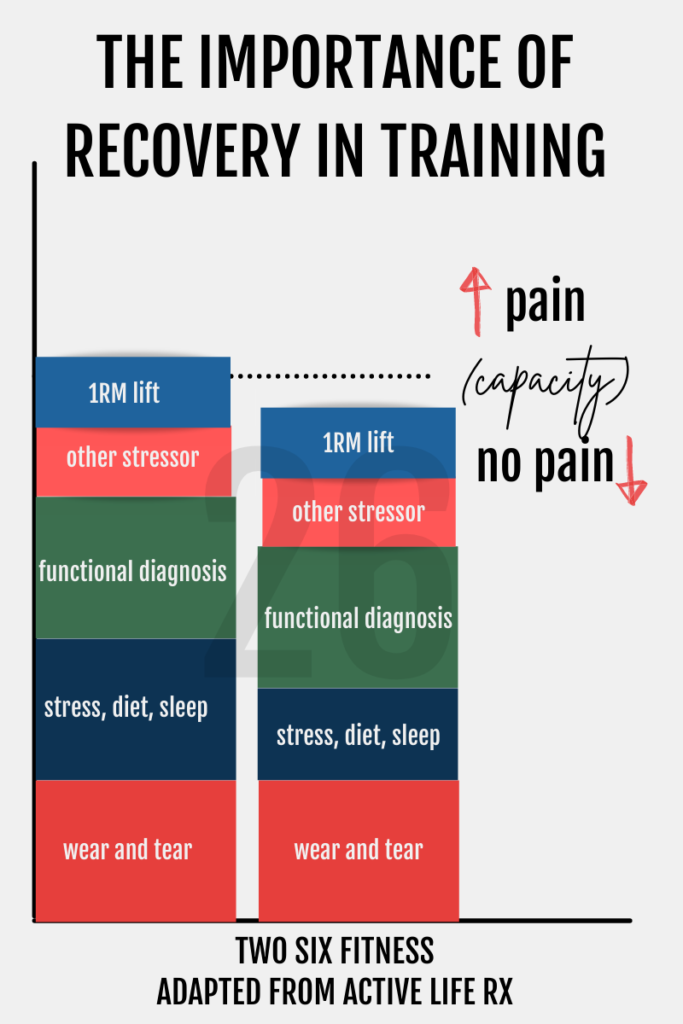If your training mentality is “no pain, no gain,” then you probably won’t like what I have to say today (but definitely need to hear it). Neglecting rest and recovery is like speeding to get somewhere on time. It seems like the fastest way to get where you’re going, but you end up 30 minutes late because you got pulled over. In other words, not taking time to rest and recover practically guarantees training setbacks in the form of pain or injury. This post will look at the importance of rest and recovery for injury prevention.
Hopefully you’ve never gotten hurt in the gym and never ever will. But if you have, how did you recount your injury after the fact? Did you blame it on “that last deadlift”? Was it “that final round of power snatches that did it”?
That last deadlift or final round of power snatches certainly may have contributed to your injury, but it’s unlikely that those movements alone did you in.
Why Injury Happens
Pain and injury happen when we push our bodies beyond their capacity to bear stress. Training is part of it, but there are other factors at play.
The first consideration is how much wear and tear your body has been through. This may include factors you can’t change, like previous surgeries and chronic medical conditions.
Now, do you have any daily routines that are taxing on your body? Long commutes? Sitting at a desk for hours on end? Extra metcons on the regular in addition to your programmed workouts? Add that to your list of stressors.
Let’s also add any sort of functional diagnoses you have related to your fitness. Does your back hurt when you kip? Do your ankles get creaky with box jumps? These are bodily stresses that bring you closer to reaching your capacity (and not in a good way).

The Importance of Rest and Recovery for Injury Prevention
Finally, let’s take a look at your recovery (specifically, sleep, diet, and stress). Are you sleeping less than 7 hours per night? What’s your diet like? Are you drinking too much alcohol or eating lots of highly processed foods? Are you getting enough protein, fat, and carbohydrates to match your activity levels? What about stress? Do you spend time each day on activities that lower your stress level?
My point is, the effects of these stressors are cumulative. This is why saying that “that last deadlift” is to blame for an injury doesn’t tell the whole story. That deadlift was probably just the tipping point.
This may be sounding all judgey and blamey, but it’s actually good news! It means that you don’t necessarily HAVE to give up lifting at the heavier end of your range, as long as you are willing to make some other changes to your life (and once you’re recovered, of course).
Some of these stressors, like wear and tear, are out of our control. We can’t change the fact that we’ve had knee surgery or 3 c-sections. We CAN see a PT/Chiro, do mobility work, or modify movements to lessen the burden of our functional diagnoses, at least to some degree.
Can we eliminate or lessen the burden of daily routines? It depends. Some of these routines exist because of factors that are out of our control, such as socioeconomic status. Others, like 3 metcons a day, are certainly within your power to change (ahem, cough cough).
Perhaps the biggest area we can impact, though, is our rest and recovery—including our sleep, diet, and emotional stress.
If you’re only getting 5 hours of sleep per night, can you get to at least 7? Sleep is when our bodies build and repair muscle.
If your diet is filled with processed foods, can you make some simple swaps to fuel your body better? This will ensure that you have the proper nutrients to support training (and life!).
If you’re living in a state of fight or flight due to chronic stress, what is something you can do for 10-20 minutes every single day to blow off steam? Ongoing emotional stress makes recovery from training more difficult and leaves you much more vulnerable to injury.
As you can see above, shrinking the size of our stress/sleep/diet burden could, in theory, bring us below our pain and injury threshold without making other changes and WITHOUT skipping heavy deadlift day.
Hopefully this article has made you understand the importance of rest and recovery for training, or at least convinced you to look at your own sleep, stress, and diet. This is going to be a major theme at 26 in 2021, so buckle up!
But if you’d like to get to work on a stronger recovery plan right away, grab your calendar and book a couple of appointments with us:
- Click here to schedule a free 15-minute movement screen (type “movement screen” in the appointment notes).
- Click here to schedule a free 15-minute nutrition consult (type “nutrition” in the appointment notes).
(Don’t see a time you love? No worries! Email [email protected] and we’ll get you in!)
Let’s get those appointments booked and get on with your healthiest, strongest year yet!
Note: This post was inspired by a lecture I attended during the Active Life Immersion Course. If you’re a fitness professional interested in this topic, definitely give Active Life a look!

